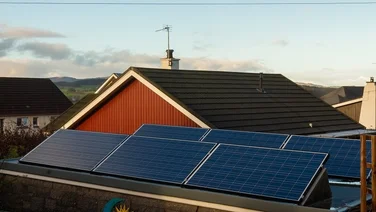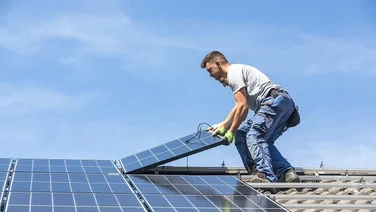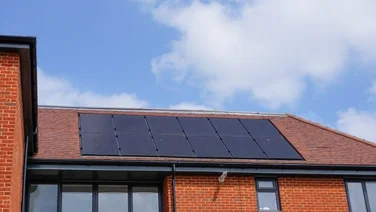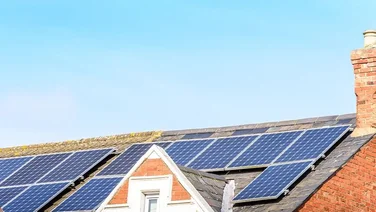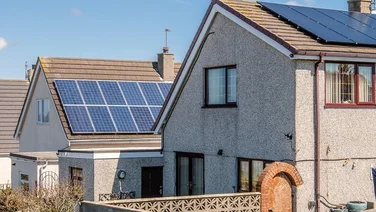- What is a solar oven and how do they work?
- How much does a solar oven cost?
- The pros and cons of solar ovens
- Advantages of solar ovens
- Disadvantages of solar ovens
- Do solar ovens work in the UK?
- What type of food can you cook in a solar oven?
- Do solar ovens require much maintenance?
- Types of solar oven
- Summary
- Solar ovens use sunlight to cook food without the need for fuel or electricity
- The three main types are box, panel, and parabolic solar ovens
- Solar ovens cost between £100 and £300, on average

Solar ovens aren’t new, but in light of recent energy disruptions in countries like Spain and Portugal, now is the time to start thinking about them as an alternative means of cooking in case you’re faced with a power cut.
While often used by campers or in off-grid rural areas of China and India, solar ovens can also help you cut cooking energy by up to 50%, saving hundreds of pounds annually.
If this interests you, read on to learn how solar ovens work, what you can cook with them, their pros and cons, and how much they typically cost, starting from just £50.
What is a solar oven and how do they work?
A solar oven, or solar cooker, is a device that uses sunlight to generate heat for cooking food or heating liquids—no gas, electricity, or firewood needed. They’re lightweight, easy to set up, and popular for camping or emergency use.
You can even build your own with basic materials like cardboard, aluminium foil, and clear plastic or glass.
Solar ovens work by concentrating sunlight onto a single area—usually a dark, heat-absorbing cooking pot—using reflective surfaces like mirrors or foil panels. When sunlight hits the pot, its energy is absorbed and converted into heat (infrared radiation).
A transparent lid or cover traps this heat inside, creating a mini greenhouse effect that steadily raises the temperature.
To get the best results, place the oven outside in direct sunlight, ideally facing south. Midday (between 11 a.m. and 3 p.m. in the UK) offers the strongest sun. Depending on the design, outdoor temperature, and what’s being cooked, meals can take between one and four hours.
While you can use a solar oven on a balcony or window ledge, exposure to full sunlight makes a big difference.
How much can I save with a solar oven?
Using a solar oven can significantly cut your energy costs by reducing dependence on gas, electricity, or firewood. These ovens, particularly those with parabolic collectors, are highly efficient, reaching up to 53.62% efficiency compared to 35.86% for standard solar models.
By harnessing solar energy, households can lower fuel expenses and reduce greenhouse gas emissions. This switch decreases air pollution and supports sustainable living by reducing deforestation and fossil fuel use.
Using a solar cooker could save around 2,250 kJ of energy per meal for a family of five. Over time, the savings add up—families with a 3kW solar panel system could potentially save up to £440 a year, according to The Guardian.
How much does a solar oven cost?
On average, you can get a decent solar oven for between £100 and £300.
Solar ovens can cost as little as £50 for foldaway box-type ovens, and as much as £1,500 for large parabolic ovens.
Box and panel solar ovens are the cheapest type, while parabolic solar ovens are more expensive, usually costing at least £400.
Of course, you can make your own from scratch, but with decent, affordable models available, it can be a false economy.

Box solar oven
Panel solar ovens are made of reflective panels. One panel serves as a base, and the others form a closed square or hexagon. The cooking pot is placed in the middle of the panels, on the base.
This type of solar oven is lightweight, so it’s ideal for use on the go. But panel solar ovens aren’t as well-insulated as box solar ovens, so they don’t get quite as hot. They’re best for foods with short cooking times.
The pros and cons of solar ovens
- Emissions-free cooking
- Good backup for camping emergencies
- No running costs
- Can be a DIY project
- Dependent on weather conditions
- Some models are quite bulky
- Some models can be expensive
- Not always as hot as other types of on-the-go cooking technology
Advantages of solar ovens
One key advantage of solar ovens is that they offer emissions-free cooking. Unlike gas stoves, they aren’t powered by fossil fuels and don’t require electricity, which is not all generated sustainably.
Because solar ovens are powered by the sun, they’re also a good backup if you run out of power from your generator when camping, or if you just want to preserve power for things such as charging phones.
Plus, since solar ovens require zero fuel or electricity, they’re entirely free to run—fuel and electricity (unless they come from a portable solar panel) cost money.
If you’re interested in living off the grid and want to know how solar panels can help, read our dedicated guide.
You don’t need to spend money on a solar oven either; you can make DIY versions with materials you have at home. One way to do this is with an old cardboard box, lined with aluminium, and a glass or plastic sheet.
Disadvantages of solar ovens
Solar ovens’ main disadvantage is that they depend on the weather. They don’t work in rainy or heavily overcast conditions or at night, so they won’t work if the conditions aren’t optimal.
Some solar ovens, especially parabolic solar ovens, can also be bulky. This means they aren’t ideal to take with you on a hike, and they take room in the car if you’re driving somewhere to camp.
Price can also be an issue. Some fancier parabolic solar cookers cost over £1,000 – far more than you’d pay for a hot plate.
Lastly, the cheapest and most accessible solar ovens—box and panel ovens—don’t get as hot as regular ovens or hot plates. This means you can only make a limited number of dishes using them, and cooking times might be long.
Do solar ovens work in the UK?
Solar ovens work in the UK, but they depend on weather conditions. They need to be sunny, although they can sometimes work under light clouds.
As we know, the sun can be in short supply in the UK, so if you plan on using a solar oven on your next camping trip, it’s best to check the forecast. Solar ovens also work at temperatures as low as 0°C, so you don’t need to wait for a heatwave to use one in the UK.
However, solar ovens work better when it’s hot out since they don’t need to build up as much heat and don’t lose warmth as quickly as in colder weather.
What type of food can you cook in a solar oven?
A solar oven can cook almost any type of food. However, grilling foods such as bacon and eggs or cooking pasta in a solar oven might be challenging.
Boiling water or grilling food requires a higher temperature than most solar ovens can create. Some solar ovens can do this, but they’re expensive and less common. This doesn’t mean you can’t cook eggs or bacon using a typical solar oven; they just won’t be crispy.
Solar ovens generally work best with slightly wet meals that can be cooked in one pot. This includes stews, baked beans, shakshuka, and rice dishes. They can even bake desserts, such as cakes or biscuits.
Do solar ovens require much maintenance?
Solar ovens do not require much maintenance. The main thing you need to do is keep them clean.
This is especially important when it comes to the reflective or glass surfaces of the solar oven. Dust or grime build-up can hinder the solar oven’s ability to reflect and concentrate sunlight, so be sure to keep those surfaces clean.
Solar ovens can be cleaned with a damp soft cloth, and a little detergent if needed. Just make sure to remove any soap residue after cleaning, and buff the surfaces with a dry cloth to keep them shiny.
Types of solar oven
The four main types of solar ovens are box solar ovens, panel solar ovens, tube cookers, and parabolic solar ovens.
The first, box solar ovens are, as the name suggests, in the shape of a box. They typically have an interior that’s lined with a reflective material, and a clear lid that can be opened and closed.
They’re well insulated, and can get as hot as 150°C. Plus, if they’re large enough, multiple cooking pots can be placed inside them to cook food.

The second, called panel solar ovens, is made of reflective panels. One panel serves as a base, and the others form a closed square or hexagon. The cooking pot is placed on the base in the middle of the panels.
This type of solar oven is lightweight, so it’s ideal for use on the go. But panel solar ovens aren’t as well-insulated as box solar ovens, so they don’t get quite as hot. They’re best for foods with short cooking times.

The third type is a parabolic solar oven. These are typically round and slightly concave. Like other solar ovens, their inner part is lined with a reflective material. They have a pole that sticks up through their centre, with a platform on the end where the cooking pot can be placed.
Their shape allows a lot of solar energy to be concentrated onto a single spot: the platform where the cooking pot is placed. This means they can heat pots to very high temperatures—up to 200°C sometimes—and can be used for grilling foods or heating water.
The caveat is that they’re relatively wide and can be challenging to transport. They also need to be redirected as the sun’s position changes.

Lastly, evacuated tube cookers are a relatively new addition to the solar cooking market, but they’re quickly gaining popularity. These cookers use a large vacuum-sealed glass tube surrounded by reflective panels, allowing them to reach impressive temperatures of 550°F (290°C) or more.
That’s hot enough to cook meat, bake bread, roast vegetables, or even make dessert. Like all solar cookers, they rely on sunlight, but evacuated tube models perform surprisingly well even in overcast conditions.
Summary
- Solar ovens offer a clean, fuel-free cooking method using only the sun’s power.
- They’re ideal for camping, off-grid living, or simply cutting energy use at home.
- With zero running costs and minimal maintenance, they’re a budget-friendly option.
- From slow-cooked stews to baked treats, solar ovens are surprisingly versatile.
- A solar oven is a wise, sustainable choice whether you’re eco-conscious or just curious.



